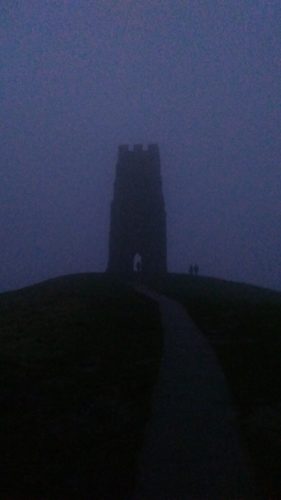![]()
The sky has begun to purple above Glastonbury. The water from the White Spring has mostly dried from my body by now, though I doubt this pair of socks will ever really be wearable again. My friend Claudia, her son, and I stand now at the bottom of a very tall hill, one that looms even larger in the Pagan imagination than it does in reality: Glastonbury Tor.

Glastonbury Tor [photo by E. Scott].
Our new friends from the White Spring, the lovely people who convinced me to jump naked into the chill January water, have gone on ahead of us. As we begin to make our way up the tor, I squint, searching for them, two dark shapes against the mass of the hill, but I cannot find them. They may have already made it to the top; we spent too much time dallying at the car, eating graham crackers and changing boots. This searching also gives me the chance to take in the size of the tor: about 500 feet, so I have read. 500 feet does not strike me as being so tall in absolute terms — barely a fourth of the height of an official U.K. mountain — but it seems huge by comparison to the landscape around it. Perhaps this comes from it being barren of trees; much like my beloved Icelandic landscapes, being able to see the shape of the tor with only the grass covering it emphasizes its character and weight, and makes it strange.
I realize at this moment that although it should not be a hard climb, it will still be a climb, and I am dreadfully out of shape.
A few moments after we start to climb the hill, Claudia’s son stops, pats himself down, and panics. “Where’s my phone?” he asks, and begins to look around with a mania reserved for teenagers.
“Well where did you put it, dear?” asks Claudia, and they start their mental pilgrimage back to the parking lot, trying to remember where he might have dropped it. Claudia grimaces at me while her son takes off back down the hill. “You should go on ahead,” she says. “We might be a moment.”
While my instincts tell me to help look, the gloaming continues to set in, and I worry that before long it will be too dark to enjoy the view from the top. I nod and continue climbing.
The mists have started to settle on the tor. Ahead, the black spike of the tower of St. Michael wavers in and out of vision, hidden by the cloud-fall. I am not sure if the scene is a literal Fata Morgana — the mirage named for Morgan le Fay, where an object appears to float upon the mist — but the tower, beautiful and foreboding, seems like something out of another world regardless. I want to chuckle — I am literally entering the mists of Avalon — but the scene fills me with solemnity. My feet clack against the concrete path that cuts across the seven terraces of the tor, and with each step, I feel myself being pulled further across the threshold.
(And yet – there are sheep, grazing, sleeping, playing on the terrace. What does the milk of the otherworld taste of?)

The tower of St. Michael [photo by E. Scott].
I can see Claudia, far below, walking up the steps alone, and I wonder if her son ever found his phone, and what the tor means to him, who sees it once a month.
There is a point where the steps end and the concrete flows straight up the hill; it’s at that point when it finally seems to be a place one can reach, where one’s feet could stand. The tower comes into view, enough to finally make out some details: its crenelated top and its arched entryways. Despite appearing out of time, the tower itself dates to only the 15th century’ “only,” I say, as though 600 years were a mere holiday jaunt.
But that is the feeling of deep time I have had since I arrived in England and stepped through one side of the threshold back at Stonehenge. I felt it there, and at the Rollright Stones, and here: these places bring to my mind a connection to a time unknowable. Not inexplicable, for our archeologists and our historians and our anthropologists of religion have done so much to uncover what can be uncovered, to theorize on what pieces of the jigsaw have survived. We can explain, but we cannot know, really.
I know that before this hollow tower sat alone atop the tor, it belonged to a church, and that at one point, it was the new church, built atop the ruins of one before, and perhaps one before that; and long before the Christians built churches here, there were heathen burials, metalworkers, collectors of pottery. Some of them terraced the hill, and some built homes, and some built churches; and I am conscious, in this moment, of my footsteps tracing their footsteps, of the mists descending on the tor before them, of the holy mystery that existed before even the Neolithic peoples came to Glastonbury Tor.

Inside the hollow tower [photo by E. Scott].
* * *
The views and opinions expressed by our diverse panel of columnists and guest writers represent the many diverging perspectives held within the global Pagan, Heathen and polytheist communities, but do not necessarily reflect the views of The Wild Hunt Inc. or its management.
The Wild Hunt is not responsible for links to external content.
To join a conversation on this post:
Visit our The Wild Hunt subreddit! Point your favorite browser to https://www.reddit.com/r/The_Wild_Hunt_News/, then click “JOIN”. Make sure to click the bell, too, to be notified of new articles posted to our subreddit.